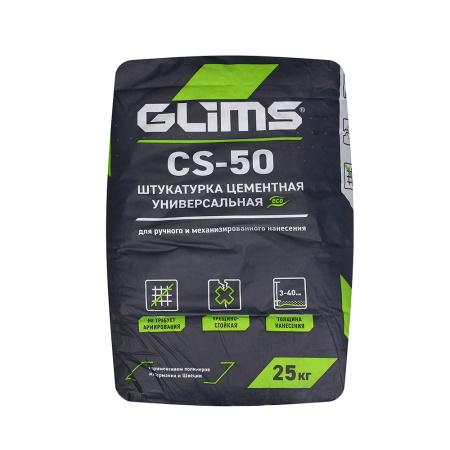The universal mixed cement plaster. It is applied to lower stratum made of autoclaved lightweight concrete and porous concrete, Ytong blocks, to the brick walls made of clinker bricks, loam bricks and sand-lime bricks, to porous ceramic blocks, to slag blocks, LECA blocks, to site concrete, as well as to previously plastered surfaces. It is suitable for manual and mechanical application.
ADVANTAGES
- It is easily leveled and does not form reinforcement
- compatible with all coating materials
- vapor permeable
- complies with European standards (EN 998-1 Class CSII T2 W2)
- cost-efficient
- longeval
- manual and mechanical application
- easy application
- does not require reinforcement
SURFACE PREPARATION
When applying and hardening the finishing mortar the temperature of the lower stratum and the environment should not be lower than +5 ° C. Before applying it is forbidden to cover the surface with drying oil, soap, etc. It is recommended to remove highly absorbent, dusty and loose layers from the surface. The surface of site concrete, brick walls made of ceramic bricks, concrete and slag blocks must be pre-treated once with a primer GLIMS®PrimeГрунт or GLIMS® DeepPrimeГрунт. The surface of brick walls made of silicate bricks, autoclaved lightweight concrete, LECA or old plastered surfaces are recommended to be twice treated with a GLIMS primer (“wet on wet”).
MORTAR PREPARATION
Pour the package contents into a reservoir with clean water at a rate of 0.18-0.20 l of water per 1 kg of dry mix (4.5-5 l per bag of 25 kg) and mix thoroughly with a mixer or drill with a nozzle to even consistency. Keep the resulting mixture for 3-5 minutes and mix it once more. Use the mortar within 180 minutes. When thickening “revive” the mortar by mixing without addition of water.
TECHNOLOGY OF WORK EXECUTION
Manual method. The resulting mortar mix is applied to the surface using a stucco hawk or trowel, then it is leveled by the screed bar. The thickness of one layer should not exceed 40 mm. The second layer of plaster is allowed to be applied only after the complete drying out of the first one.
The mechanical method. The finished mortar mix is applied evenly to the lower stratum with an overlapping of about 5 cm. The flow coming out of the nozzle perpendicular to the lower stratum should lie on the wall as a "herringbone".
Screeding. Within 20-40 minutes from the time of application the mortar applied to the lower stratum surface must be evenly leveled according to pre-installed joint displacement indicator bars using the screed bar.
Undercutting. When the applied mixed plaster begins to set (approximately in 60-90 minutes after application), the surface can be leveled with a screed bar by undercutting, keeping it perpendicular to the lower stratum, striking off surplus material and filling the recessions with a fresh mortar.
Float finish. To prepare the surface for painting 90 minutes after screeding and/or undercutting it is possible to trowel the plaster with a plastic float. Depending on the ambient humidity and temperature, as well as the thickness of the layer, the float finish time may vary.
ADDITIONAL RECOMMENDATIONS
If it is necessary to achieve a perfectly smooth surface after applying the GLIMS®CS-50 plaster, it is recommended to use GLIMS®Finish-F or GLIMS®Finish-R finish cement filler or GLIMS®Stukko-RF cement standard filler.
CONSUMPTION
1.4-1.5 kg/m² with a layer thickness of 1 mm.
PACKAGING
kraft paper bag 25 kg (net).
TRANSPORTATION AND STORAGE
During transportation and storage, bags with dry mortar should be protected from damage and soaking. The storage period is 12 months. TU5745-010-40397319-2003№0370/14
OPERATION
The material is environmentally friendly in use and operation. Operation temperature range – from -50 to +70 ° С.
PRODUCT DISPOSAL
Dry mortar and hardened material must be disposed as building waste. It is forbidden to throw materials into the sanitary piping. The kraft paper bags should be disposed as household garbage.

